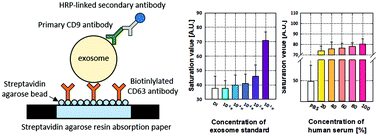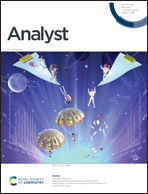Enhanced paper-based ELISA for simultaneous EVs/exosome isolation and detection using streptavidin agarose-based immobilization†
Abstract
EVs/exosomes are considered as the next generation of biomarkers, including for liquid biopsies. Consequently, the quantification of EVs/exosomes is crucial for facilitating EV/exosome research and applications. Paper-based enzyme-linked immunosorbent assay (p-ELISA) is a portable diagnostic system with low cost that is simple and easy to use; however, it shows low sensitivity and linearity. In this study, we develop p-ELISA for targeting EVs/exosomes by using streptavidin agarose resin-based immobilization (SARBI). This method reduces assay preparation times, provides strong binding, and retains good sensitivity and linearity. The time required for the total assay, including preparation steps and surface immobilization, was shortened to ∼2 h. We evaluated SARBI p-ELISA systems with/without CD63 capture Ab and then with fetal bovine serum (FBS) and EVs/exosome-depleted fetal bovine serum (dFBS). The results provide evidence supporting the selective capture ability of SARBI p-ELISA. We obtain semiquantitative p-ELISA results using an exosome standard (ES) and human serum (HS), with R2 values of 0.95 and 0.92, respectively.



 Please wait while we load your content...
Please wait while we load your content...